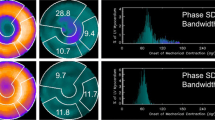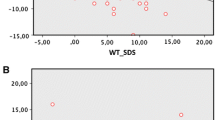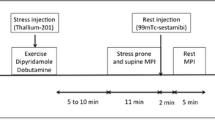Abstract
To assess the efficacy of early reinjection forpredicting post intervention improvement in thallium-201 (Tl) uptake and regional wall motion, we reinjected a small dose of Tl following post-stress imaging and obtained reinjection early images (10 min after early reinjection) and reinjection delayed images (3 hr afterwards) in 40 patients who were referred to us for revascularization (group I). Twenty-nine patients in group I also underwent conventional stress-redistribution Tl scintigraphy (group II). Conventional stress-redistribution Tl scintigraphy was repeated after intervention. Contrast left ventriculography was performed before and after intervention and changes in regional wall motion were assessed in 22 of 40 patients. In group I, the predictive value for improvement and no improvement (the accuracy) of reinjection early images in perfusion was 83%, while that of reinjection delayed images was 91%. Furthermore, the accuracy of reinjection early images in regional wall motion was 80%, while it was 91% for reinjection delayed images. In group II, the accuracy in perfusion was 78% and the value in regional wall motion was 70%. Both accuracy in perfusion and in regional wall motion obtained from reinjection delayed images were significantly higher than the values in group II (p < 0.05). These data suggest that early reinjection is useful for predicting postintervention thallium uptake and regional wall motion.
Similar content being viewed by others
References
Pohost GM, Zir LM, Moore RH, McKusick KA, Guiney TE, Beller GA. Differentiation of transiently ischemic from infarcted myocardium by serial imaging after a single dose of thallium-201.Circulation 55: 294–302, 1977.
Strauss HW, Harrison K, Langan JK, Lebowitz E, Pitt B. Thallium-201 for myocardial imaging—Relation of thallium-201 to regional myocardial perfusion.Circulation 51: 641–645, 1975.
Gibson RS, Watson DD, Taylor GJ, Crosby IK, Wellons HL, Holt ND. Prospective assessment of regional myocardial perfusion before and after coronary revascularization surgery by quantitative thallium-201 scintigraphy.JACC 1: 804–815, 1983.
Liu P, Kiess MC, Okada RD, Block PC, Strauss HW, Pohost GM, et al. The persistent defect on exercise thallium imaging and its fate after myocardial revascularization: Does it represent scar or ischemia?Am Heart J 110: 996–1001, 1985.
Brunken R, Schwaiger M, Grover-Mckay M, Phelps ME, Tillisch J, Schelbert HR. Positron emission tomography detects tissue metabolic activity in myocardial segments with persistent thallium perfusion defects.JACC 10: 557–567, 1987.
Tamaki N, Yonekura Y, Yamashita K, et al. SPECT thallium-201 tomography and positron tomography using N-13 ammonia and F-18 fluorodeoxyglucose in coronary heart disease.Am J Cardiac Imaging 3: 3–9, 1989.
Rocco TP, Dilsizian V, Maltais F, Strauss HW, Boucher CA, McKusick KA. Thallium reinjection after delayed imaging demonstrates fill-in to regions with “fixed” defects (abstract).J Nucl Med 29: 769, 1988.
Rocco TP, Dilsizian V, McKusick KA, Fischman AJ, Boucher CA, Strauss HW. Comparison of thallium redistribution with rest “reinjection” imaging for the detection of viable myocardium.Am J Cardiol 66: 158–163, 1990.
Dilsizian V, Rocco TP, Freedman NMT, Leon MB, Bonow RO. Enhanced detection of ischemic but viable myocardium by the reinjection of thallium after stress-redistribution imaging.N Engl J Med 323: 141–146, 1990.
Righetti A, Crawford MH, O’Rourke RA, Schelbert H, Daily PO, Ross J Jr. Interventricular septal motion and left ventricular function after coronary bypass surgery: Evaluation with echocardiography and radionuclide angiography.Am J Cardiol 39: 372–377, 1977.
Tamaki N, Yonekura Y, Yamashita K, Senda M, Saji H, Konishi J, et al. Value of rest-stress myocardial positron tomography using nitrogen-13 ammonia for the preoperative prediction of reversible asynergy.J Nucl Med 30: 1302–1310, 1989.
Bonow RO, Dilsizian V. Thallium 201 for assessment of myocardial viability.Sem Nucl Med 21: 230–241, 1991.
Iskandrian AS. Thallium reinjection imaging: the search for an optimal protocol.J Nucl Med 34: 743–746, 1993.
Blood DK, McCarthy DM, Sciacca RR, Cannon PJ. Comparison single-dose and double-dose thallium-201 myocardial perfusion scintigraphy for the detection of coronary artery disease and prior myocardial infarction.Circulation 58: 777–788, 1978.
Ritchie JL, Albro PC, Caldwell JH, Trobaugh GB, Hamil-ton GW. Thaliium-201 myocardial imaging: A comparison of the redistribution and rest images.J Nucl Med 20: 477–483, 1979.
Ohtani H, Tamaki N, Yonekura Y, Mohiuddin IH, Hirata K, Ban T, et al. Value of thallium-201 reinjection after delayed SPECT imaging for predicting reversible ischemia after coronary artery bypass grafting.Am J Cardiol 66: 394–399, 1990.
Tamaki N, Ohtani H, Yonekura Y, Nohara R, Kambara H, Kawai C, et al. Significance of fill-in after thallium-201 reinjection following delayed imaging: Comparison with regional wall motion and angiographie findings.J Nucl Med 31: 1617–1623, 1990.
Cloninger KG, DePuey EG, Garcia EV, Roubin GS, Robbins WL, Nody A, et al. Incomplete redistribution in delayed thallium-201 single photon emission computed tomography (SPECT) images: an overestimation of myocardial scarring.JACC 12: 955–963, 1988.
Kiat H, Berman DS, Maddahi J, Yang LD, Train KV, Rozanski A, et al. Late reversibility of tomographic myocardial thallium-201 defects: An accurate marker of myocardial viability.JACC 12: 1456–1463, 1988.
Yang LD, Berman DS, Kiat H, Resser KJ, Friedman JD, Rozanski A, et al. The frequency of late reversibility in SPECT thallium-201 stress-redistribution studies.JACC 15: 334–340, 1990.
Dilsizian V, Smeltzer WR, Freedman NMT, Dextras R, Bonow RO. Thallium reinjection after stress-redistribution imaging: Does 24-hour delayed imaging after reinjection enhance detection of viable myocardium?Circulation 83: 1247–1255, 1991.
Kiat H, Friedman JD, Wang FP, et al. Frequency of late reversibility in stress-redistribution thallium-201 SPECT using an early reinjection protocol.Am Heart J 122: 613–619, 1991.
Kayden DS, Sigal S, Soufer R, Mattera J, Zaret BL, Wackers FT. Thallium-201 for assessment of myocardial viability: Quantitative comparison of 24-hour redistribution imaging with imaging after reinjection at rest.JACC 18: 1480–1486, 1991.
Verani MS, Jhingran S, Attar M, Rizk A, Quinones MA, Miller RR. Poststress redistribution of thallium-201 in patients with coronary artery disease, with and without prior myocardial infarction.Am J Cardiol 43: 1114–1122, 1979.
Berman D, Maddahi J, Charuzi Y, Waxman A, Diamond G, Swan HJC, et al. Rate of redistribution in Tl-201 exercise myocardial scintigraphy: Inverse relationship to degree of coronary stenosis.[abstract]Circulation 58 (suppl II): II-63, 1978.
Gutman J, Berman DS, Freeman M, Rozanski A, Maddahi J, Waxman A, et al. Time to completed redistribution of thallium-201 in exercise myocardial scintigraphy: Relationship to the degree of coronary artery stenosis.Am Heart J 106: 989–995, 1983.
Van Eck-Smit BLF, van der Wall EE, Kuijper AFM, Pauwels EKJ. Immediate thallium-201 reinjection following stress imaging: A time-saving approach for detection of myocardial viability.J Nucl Med 34: 737–743, 1993.
Budinger TF, Pohost GM. Thallium “redistribution”—an explanation. [abstract]J Nucl Med 27: 996, 1986.
Budinger TF, Knittel BL. Cardiac thallium redistribution and model. [abstract]J Nucl Med 28: 588, 1987.
Author information
Authors and Affiliations
Rights and permissions
About this article
Cite this article
Yoshida, H., Sakata, K., Mochizuki, M. et al. Value of thallium-201 early reinjection for assessment of myocardial viability. Ann Nucl Med 8, 31–40 (1994). https://doi.org/10.1007/BF03164984
Received:
Accepted:
Issue Date:
DOI: https://doi.org/10.1007/BF03164984




